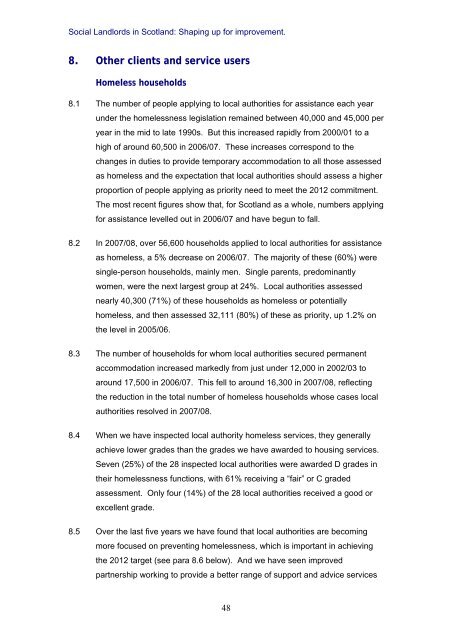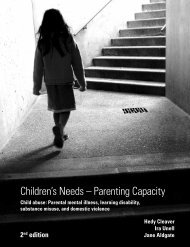Social Landlords in Scotland: Shaping up for improvement
Social Landlords in Scotland: Shaping up for improvement
Social Landlords in Scotland: Shaping up for improvement
You also want an ePaper? Increase the reach of your titles
YUMPU automatically turns print PDFs into web optimized ePapers that Google loves.
<strong>Social</strong> <strong>Landlords</strong> <strong>in</strong> <strong>Scotland</strong>: Shap<strong>in</strong>g <strong>up</strong> <strong>for</strong> <strong>improvement</strong>.8. Other clients and service usersHomeless households8.1 The number of people apply<strong>in</strong>g to local authorities <strong>for</strong> assistance each yearunder the homelessness legislation rema<strong>in</strong>ed between 40,000 and 45,000 peryear <strong>in</strong> the mid to late 1990s. But this <strong>in</strong>creased rapidly from 2000/01 to ahigh of around 60,500 <strong>in</strong> 2006/07. These <strong>in</strong>creases correspond to thechanges <strong>in</strong> duties to provide temporary accommodation to all those assessedas homeless and the expectation that local authorities should assess a higherproportion of people apply<strong>in</strong>g as priority need to meet the 2012 commitment.The most recent figures show that, <strong>for</strong> <strong>Scotland</strong> as a whole, numbers apply<strong>in</strong>g<strong>for</strong> assistance levelled out <strong>in</strong> 2006/07 and have begun to fall.8.2 In 2007/08, over 56,600 households applied to local authorities <strong>for</strong> assistanceas homeless, a 5% decrease on 2006/07. The majority of these (60%) weres<strong>in</strong>gle-person households, ma<strong>in</strong>ly men. S<strong>in</strong>gle parents, predom<strong>in</strong>antlywomen, were the next largest gro<strong>up</strong> at 24%. Local authorities assessednearly 40,300 (71%) of these households as homeless or potentiallyhomeless, and then assessed 32,111 (80%) of these as priority, <strong>up</strong> 1.2% onthe level <strong>in</strong> 2005/06.8.3 The number of households <strong>for</strong> whom local authorities secured permanentaccommodation <strong>in</strong>creased markedly from just under 12,000 <strong>in</strong> 2002/03 toaround 17,500 <strong>in</strong> 2006/07. This fell to around 16,300 <strong>in</strong> 2007/08, reflect<strong>in</strong>gthe reduction <strong>in</strong> the total number of homeless households whose cases localauthorities resolved <strong>in</strong> 2007/08.8.4 When we have <strong>in</strong>spected local authority homeless services, they generallyachieve lower grades than the grades we have awarded to hous<strong>in</strong>g services.Seven (25%) of the 28 <strong>in</strong>spected local authorities were awarded D grades <strong>in</strong>their homelessness functions, with 61% receiv<strong>in</strong>g a “fair” or C gradedassessment. Only four (14%) of the 28 local authorities received a good orexcellent grade.8.5 Over the last five years we have found that local authorities are becom<strong>in</strong>gmore focused on prevent<strong>in</strong>g homelessness, which is important <strong>in</strong> achiev<strong>in</strong>gthe 2012 target (see para 8.6 below). And we have seen improvedpartnership work<strong>in</strong>g to provide a better range of s<strong>up</strong>port and advice services48

















